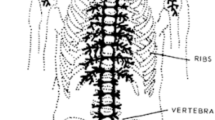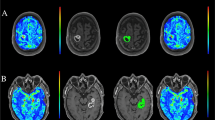Abstract
Objectives
The purpose of this study was to investigate the usefulness of T1W black-blood Cube (BB Cube) and T1W BB Cube fluid-attenuated inversion recovery (BB Cube-FLAIR) sequences for contrast-enhanced brain imaging, by evaluating flow-related artefacts, detectability, and contrast ratio (CR) of intracranial lesions among these sequences and T1W-SE.
Methods
Phantom studies were performed to determine the optimal parameters of BB Cube and BB Cube-FLAIR. A clinical study in 23 patients with intracranial lesions was performed to evaluate the usefulness of these two sequences for the diagnosis of intracranial lesions compared with the conventional 2D T1W-SE sequence.
Results
The phantom study revealed that the optimal parameters for contrast-enhanced T1W imaging were TR/TE = 500 ms/minimum in BB Cube and TR/TE/TI = 600 ms/minimum/300 ms in BB Cube-FLAIR imaging. In the clinical study, the degree of flow-related artefacts was significantly lower in BB Cube and BB Cube-FLAIR than in T1W-SE. Regarding tumour detection, BB Cube showed the best detectability; however, there were no significant differences in CR among the sequences.
Conclusions
At 1.5 T, contrast-enhanced BB Cube was a better imaging sequence for detecting brain lesions than T1W-SE or BB Cube-FLAIR.
Key Points
• Cube is a single-slab 3D FSE imaging sequence.
• We applied a black-blood (BB) imaging technique to T1W Cube.
• At 1.5 T, contrast-enhanced T1W BB Cube was valuable for detecting brain lesions.







Similar content being viewed by others
References
Chappell PM, Pelc NJ, Foo TK et al (1994) Comparison of lesion enhancement on spin-echo and gradient-echo images. AJNR Am J Neuroradiol 15:37–44
Brant-Zawadzki M, Gillan GD, Nitz WR (1992) MP RAGE: a three-dimensional, T1-weighted, gradient-echo sequence initial experience in the brain. Radiology 182:769–775
Mugler JP III (2014) Optimized three-dimensional fast-spin-echo MRI. J Magn Reson Imaging 39:745–767
Park J, Kim EY (2010) Contrast-enhanced, three-dimensional, whole-brain, black-blood imaging: application to small brain metastases. Magn Reson Med 63:553–561
Naganawa S, Satake H, Iwano S et al (2008) Contrast-enhanced MR imaging of the brain using T1-weighted FLAIR with BLADE compared with a conventional spin-echo sequence. Eur Radiol 18:337–342
Melhem ER, Bert RJ, Walker RE (1998) Usefulness of optimized Gadolinium-enhanced fast fluid-attenuated inversion recovery MR imaging in revealing lesions of the brain. AJR Am J Roentgenol 171:803–807
Landis JR, Koch GG (1977) The measurement of observer agreement for categorical data. Biometrics 33:159–174
Richardson DN, Elster AD, Williams DW III (1990) Gd-DTPA-enhanced MR images: accentuation of vascular pulsation artifacts and correction by using gradient-moment nulling (MAST). AJNR Am J Neuroradiol 11:209–210
Komada T, Naganawa S, Ogawa H et al (2008) Contrast-enhanced MR imaging of metastatic brain tumor at 3Tesla: utility of T1-weighted SPACE compared with 2D spin echo and 3D gradient echo sequence. Magn Reson Med Sci 7:13–21
Kakeda S, Korogi Y, Hiai Y et al (2007) Detection of brain metastasis at 3 T: comparison among SE, IR-FSE and 3D-GRE sequences. Eur Radiol 17:2345–2351
Goerner FL, Clarke GD (2011) Measuring signal-to-noise ratio in parallel imaging MRI. Med Phys 38:5049–5057
Yuh WTC, Tali ET, Nguyen HD et al (1995) The effect of contrast dose, Imaging time, and lesion size in the MR detection of intracerebral metastasis. AJNR Am J Neroradiol 16:373–380
Acknowledgments
The scientific guarantor of this publication is Professor Takamichi Murakami, Department of Radiology, Kinki University Faculty of Medicine. The authors of this manuscript declare no relationships with any companies whose products or services may be related to the subject matter of the article. The authors state that this work has not received any funding. One of the authors has significant statistical expertise. Institutional review board approval was obtained. Written informed consent was obtained from all subjects (patients) in this study. No study subjects or cohorts have been previously reported. Methodology: prospective, diagnostic or prognostic study, performed at one institution.
Author information
Authors and Affiliations
Corresponding author
Rights and permissions
About this article
Cite this article
Im, S., Ashikaga, R., Yagyu, Y. et al. Contrast enhancement of intracranial lesions at 1.5 T: comparison among 2D spin echo, black-blood (BB) Cube, and BB Cube-FLAIR sequences. Eur Radiol 25, 3175–3186 (2015). https://doi.org/10.1007/s00330-015-3757-5
Received:
Revised:
Accepted:
Published:
Issue Date:
DOI: https://doi.org/10.1007/s00330-015-3757-5




